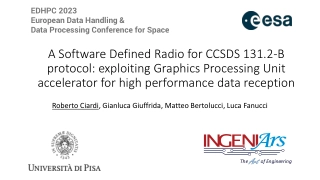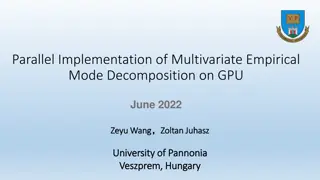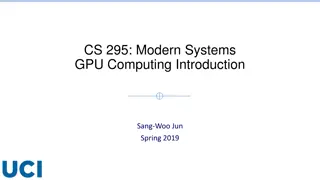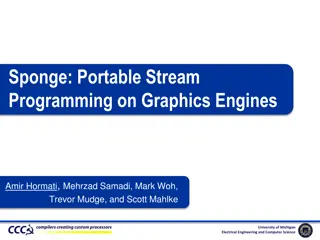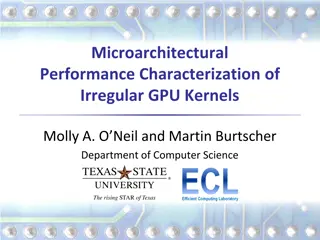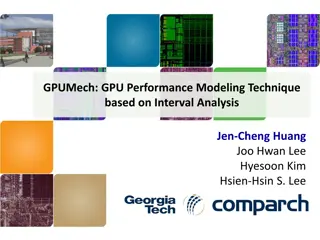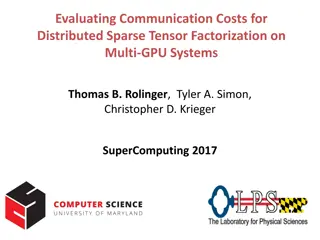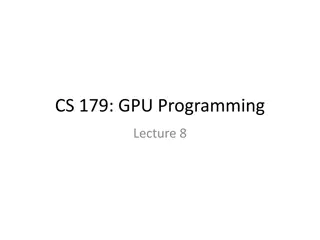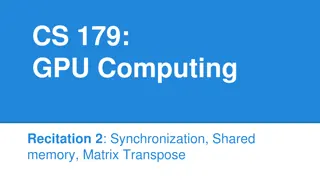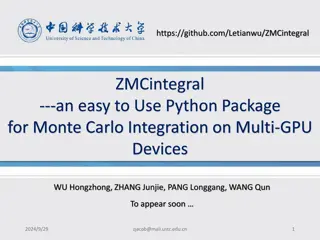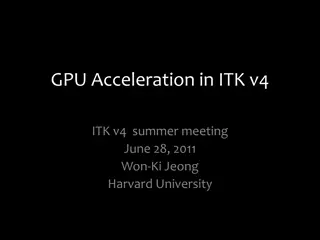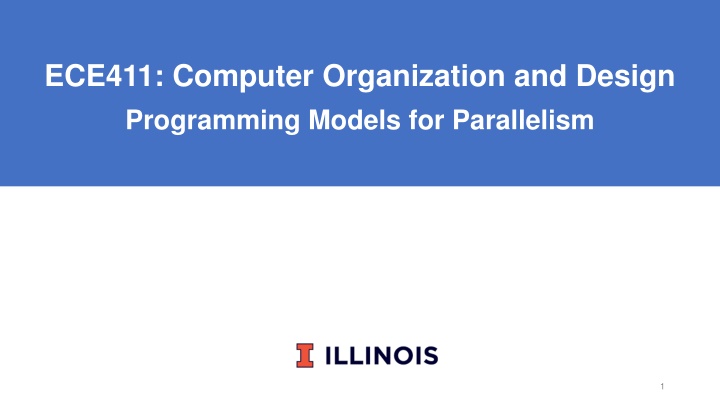
VLIW Architecture: Parallelism and Compiler Optimization
Explore the concept of Very Long Instruction Word (VLIW) architecture, focusing on its philosophy, tradeoffs, and complexities. Learn how VLIW machines leverage compiler optimization to achieve parallelism and efficiency in instruction processing.
Download Presentation

Please find below an Image/Link to download the presentation.
The content on the website is provided AS IS for your information and personal use only. It may not be sold, licensed, or shared on other websites without obtaining consent from the author. If you encounter any issues during the download, it is possible that the publisher has removed the file from their server.
You are allowed to download the files provided on this website for personal or commercial use, subject to the condition that they are used lawfully. All files are the property of their respective owners.
The content on the website is provided AS IS for your information and personal use only. It may not be sold, licensed, or shared on other websites without obtaining consent from the author.
E N D
Presentation Transcript
ECE411: Computer Organization and Design Programming Models for Parallelism 1
Complexity of OOO Execution OOO Machines attempt to dynamically builds the dataflow graph of a piece of the program to extract ILP. ISAs assume a sequential order between all instructions, even when programmer did not intent. 2
VLIW (Very Long Instruction Word) a very long instruction word consists of multiple independent instructions packed together by the compiler Packed instructions can be logically unrelated (contrast with SIMD) idea: compiler finds independent instructions and statically schedules (i.e. packs/bundles) them into a single VLIW instruction 3
VLIW Concept Fisher, Very Long Instruction Word architectures and the ELI-512, ISCA 1983. ELI: Enormously longword instructions (512 bits) 4
VLIW Philosophy Philosophy similar to RISC (simple instructions and hardware) except multiple instructions in parallel RISC (John Cocke, 1970s, IBM 801 minicomputer) compiler does the hard work to translate high-level language code to simple instructions (John Cocke: control signals) and, to reorder simple instructions for high performance hardware does little translation/decoding very simple VLIW (Fisher, ISCA 1983) compiler does the hard work to find instruction level parallelism hardware stays as simple and streamlined as possible executes each instruction in a bundle in lock step simple higher frequency, easier to design 5
VLIW Tradeoffs Advantages + no need for dynamic scheduling hardware simple hardware + no need for dependency checking within a VLIW instruction simple hardware for multiple instruction issue + no renaming + no need for instruction alignment/distribution after fetch to different functional units simple hardware Disadvantages -- compiler needs to find N independent operations -- if it cannot, inserts NOPs in a VLIW instruction -- parallelism loss AND code size increase -- recompilation required when execution width (N), instruction latencies, functional units change (Unlike superscalar processing) -- lockstep execution causes independent operations to stall -- no instruction can progress until the longest-latency instruction completes 6
Commercial VLIW Machines Multiflow TRACE, Josh Fisher (7-wide, 28-wide) Cydrome Cydra 5, Bob Rau Transmeta Crusoe: x86 binary-translated into internal VLIW TI C6000, Trimedia, STMicro (DSP & embedded processors) most successful commercially Intel IA-64 not fully VLIW, but based on VLIW principles EPIC (Explicitly Parallel Instruction Computing) instruction bundles can have dependent instructions a few bits in the instruction format specify explicitly which instructions in the bundle are dependent on which other ones 7
Flynns Taxonomy of Computers Mike Flynn, Very High-Speed Computing Systems, Proc. of IEEE, 1966 SISD: Single instruction operates on single data element SIMD: Single instruction operates on multiple data elements Array processor Vector processor MISD: Multiple instructions operate on single data element Closest form: systolic array processor, streaming processor MIMD: Multiple instructions operate on multiple data elements (multiple instruction streams) Multiprocessor Multithreaded processor 8
SIMD Processing single instruction controls simultaneous execution of many processing elements 9
Case for SIMD M. Horowitz, "1.1 Computing's energy problem (and what we can do about it)," 2014 IEEE International Solid-State Circuits Conference Digest of Technical Papers (ISSCC), 2014, pp. 10-14, doi: 10.1109/ISSCC.2014.6757323. 10
Why SIMD +more parallelism when parallelism is abundant +SIMD in addition to ILP +simple design +replicated functional units +energy efficient + only needs one instruction for many data operations +small die area +no heavily ported register files -Must be explicitly exposed to the hardware -by the compiler or by the programmer 11
SIMD Application Image graphics : 3D games, movies image recognition video encoding/decoding : JPEG, MPEG4 Sound encoding/decoding: IP phone, MP3 speech recognition digital signal processing: cell phones Scientific applications array-based data-parallel computation, another level of parallelism Machine learning training 12
Vector Processors A vector is a one-dimensional array of numbers Many scientific/commercial programs use vectors for (i = 0; i<=49; i++) C[i] = (A[i] + B[i]) / 2 A vector processor is one whose instructions operate on vectors rather than scalar (single data) values Basic requirements Need to load/store vectors vector registers (contain vectors) Need to operate on vectors of different lengths vector length register (VLEN) Elements of a vector might be stored apart from each other in memory vector stride register (VSTR) Stride: distance in memory between two elements of a vector 13
Vector Functional Units V 1 V 2 V 3 Use a deep pipeline to execute element operations fast clock cycle Control of deep pipeline is simple because elements in vector are independent V1 * V2 V3
Packed SIMD 15
Packed SIMD Variations SIMD processing units in CPU MMX: Multimedia Extensions (1996) repurpose 64-bit floating point registers eight 8-bit integer ops or four 16-bit integer ops SSE: Streaming SIMD Extensions (1999, 2001, 2004, 2007) separate 128-bit registers eight 16-bit ops, four 32-bit ops, or two 64-bit ops single-precision floating point arithmetic AVX: Advanced Vector Extension (2010) doubles the width to 256 bits, i.e., four 64-bit integer/fp ops, extendible to 512 and 1024 bits for future generations operands must be consecutive and aligned memory locations 16
Examples of Using SSE xmm1 xmm1 xmm1 X3 X2 X1 X0 X3 X2 X1 X0 X3 X3 X2 X2 X1 X1 X0 X0 xmm2 xmm2 Y3 Y2 Y1 Y0 xmm2 Y3 Y2 Y1 Y0 Y3 Y3 Y2 Y2 Y1 Y1 Y0 Y0 op op op op op Y3 .. Y0 Y3 .. Y0 Y3 Y3 X3 .. X0 X3 .. X0 X0 X1 xmm1 xmm1 xmm1 X3 X2 X1 X3 op Y3 X2 op Y2 X1 op Y1X0 op Y0 X0 op Y0 Packed SP FP operation (e.g. ADDPS xmm1, xmm2) Scalar SP FP operation (e.g. ADDSS xmm1, xmm2) Shuffle FP operation (8-bit imm) Shuffle FP operation (8-bit imm) (e.g. SHUFPS xmm1, xmm2, imm8) (e.g. SHUFPS xmm1, xmm2, 0xf1) 17
Sample GPU SIMT Code (Simplified) CPU code for (ii = 0; ii < 100; ++ii) { C[ii] = A[ii] + B[ii]; } CUDA code // there are 100 threads __global__ void KernelFunction( ) { int tid = blockDim.x * blockIdx.x + threadIdx.x; int varA = aa[tid]; int varB = bb[tid]; C[tid] = varA + varB; } Slide credit: Hyesoon Kim @ Georgia Tech 19
Latency Hiding with Thread Warps warp: a set of threads that execute the same instruction (on different data elements) warps available for scheduling thread warp 3 thread warp 8 thread warp 7 SIMD pipeline Fine-grained multithreading One instruction per thread in pipeline at a time (no branch prediction) Interleave warp execution to hide latencies Register values of all threads stay in register file No OS context switching Memory latency hiding Graphics has millions of pixels I-fetch decode RF RF RF warps accessing memory hierarchy ALU ALU ALU miss? D-cache thread warp 1 thread warp 2 all hit? data thread warp 6 writeback Optional Reading: Understanding Latency Hiding on GPUs 20 Slide credit: Tor Aamodt
Branch Divergence Problem in Warp-based SIMD SPMD (single program, multiple data) execution on SIMD hardware NVIDIA calls this Single Instruction, Multiple Thread ( SIMT ) execution A common PC thread warp B thread 1 thread 2 thread 3 thread 4 C D F E G 21 Slide credit: Tor Aamodt
Control Flow Problem in GPUs/SIMD GPU uses SIMD pipeline to save area on control logic. group scalar threads into warps Branch Branch Path A Path A Branch divergence occurs when threads inside warps branch to different execution paths. Path B Path B 22 Slide credit: Tor Aamodt
NVIDIA GeForce GTX 285 NVIDIA-speak: 240 stream processors SIMT execution Generic speak: 30 cores 8 SIMD functional units per core 23 Slide credit: Kayvon Fatahalian
NVIDIA GeForce GTX 285 core 64 KB of storage for fragment contexts (registers) = SIMD functional unit, control shared across 8 units = multiply-add = multiply = instruction stream decode = execution context storage 24 Slide credit: Kayvon Fatahalian
NVIDIA GeForce GTX 285 core 64 KB of storage for thread contexts (registers) groups of 32 threads share instruction stream (each group is a warp) up to 32 warps are simultaneously interleaved up to 1024 thread contexts can be stored 25 Slide credit: Kayvon Fatahalian
NVIDIA GeForce GTX 285 Tex Tex Tex Tex Tex Tex Tex Tex Tex Tex there are 30 of these things on the GTX 285: 30,720 threads 26 Slide credit: Kayvon Fatahalian
Case for Domain Specific Accelerators M. Horowitz, "1.1 Computing's energy problem (and what we can do about it)," 2014 IEEE International Solid-State Circuits Conference Digest of Technical Papers (ISSCC), 2014, pp. 10-14, doi: 10.1109/ISSCC.2014.6757323. 27
Domain Specific Accelerators Specialization -> Efficiency Parallelism -> Speedup Co-Design: The algorithm has to change to expose parallelism 28
Example: Systolic Arrays H. T. Kung, Why Systolic Architectures?, IEEE Computer 1982. 29
Systolic Array for GEMM Multiply two 3x3 matrices (inputs) P = M Q = N R = R + M*N 30

